Library Express: Turning the Page from Bookselling to Public Service
In Jorge Carrión’s “Bookshops,” Carrión suggests there exists a strong difference between the bookshop and the library. The bookshop is characterized as a temporary yet progressive seller of books, one who deals with a light inventory and exists to move material to work out a limited existence. On the other hand, the library is much more permanent, an extension of “the powers-that-be” stuck “looking towards the past” (40). The library is a place where the hectic movement of ideas ceases and enters a preservation or sanctuary. Thanks to its ties to the government and its power, the library’s existence will always be ensured. This is perhaps to the detriment of bookstores, for Carrión suggests that the library is so powerful it even “erase[s]” the booksellers that nurtured its collection of books (37).
Putting aside complaints about how Carrión takes the library for granted, there’s a fundamental flaw in his framework. If the library and the bookstore are such incompatible opposites, a combination of the two would prove that the bookstore and library are not so rigid in their constructs. Perhaps the bookstore does not have to be temporary or forgotten, constantly struggling for its own existence. Perhaps the library is not the place where knowledge comes to rest, stuck permanently looking at the past. Perhaps the two can coexist in a powerful, mutually beneficial service model that furthers their combined goals.
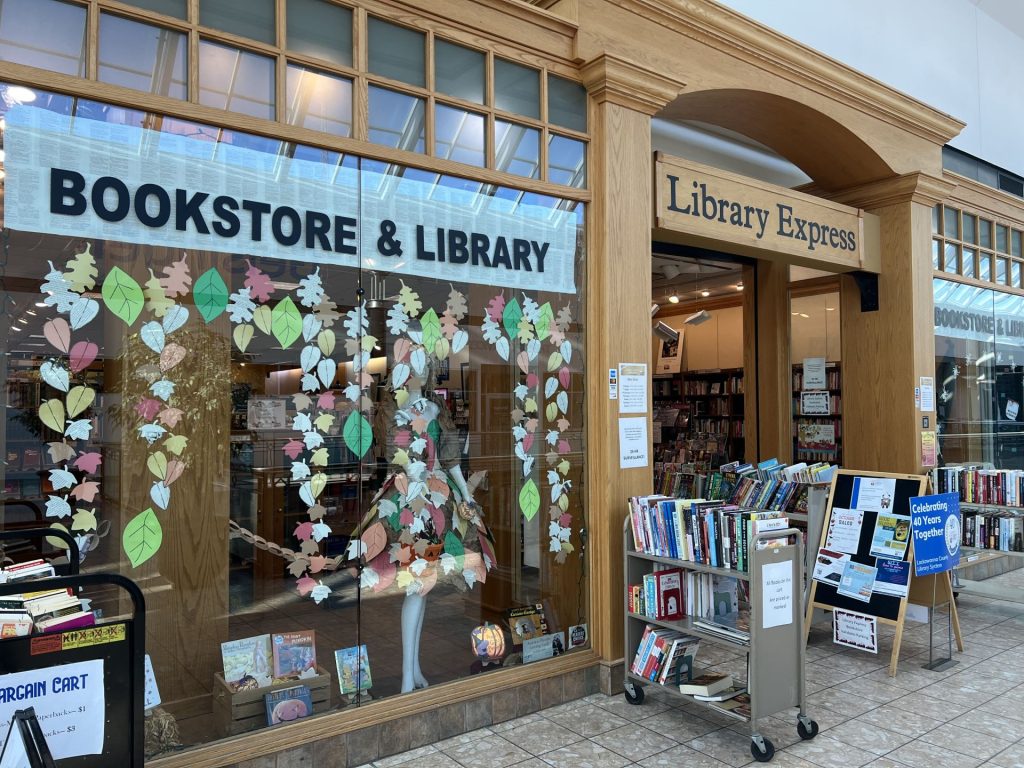
It should be obvious what we’re hinting at: this paradoxical fusion already exists. We’re looking at Library Express, a one-stop bookshop/library hybrid in the Pennsylvania Rust Belt that functions as a small-scale commercial offshoot of the Scranton library network.
Library Express challenges our fundamental understanding of both the library and the bookstore. How can a place attempting to sell books lend them away for free? How can the end-stop for knowledge traffic its wares for survival? How can a public service become a business? Yet, in its opposing existence, Library Express redefines both and offers a possible path towards a middle ground.
A map of the area surrounding Library Express showing the various stores and historical sites in industrial Scranton.
Located in the center of downtown Scranton, Library Express’s dual purpose as a bookstore/library hybrid serves its working-class community well. In this neighborhood, about 35% of household incomes are less than $15K a year. It allows people of all demographics to find what they’re looking for, whether they’re looking to buy a bestseller or borrow a book that interests them. The variety of purchasing and lending options at Library Express similarly reflects this urge to cater to those from different economic backgrounds who might have less of a disposable income. There are options to have a book mailed to your home for those unable to travel and online options for in-store pickup. Having these different options allows people of modest economic backgrounds to use the bookstore in the way that feels most comfortable to them.
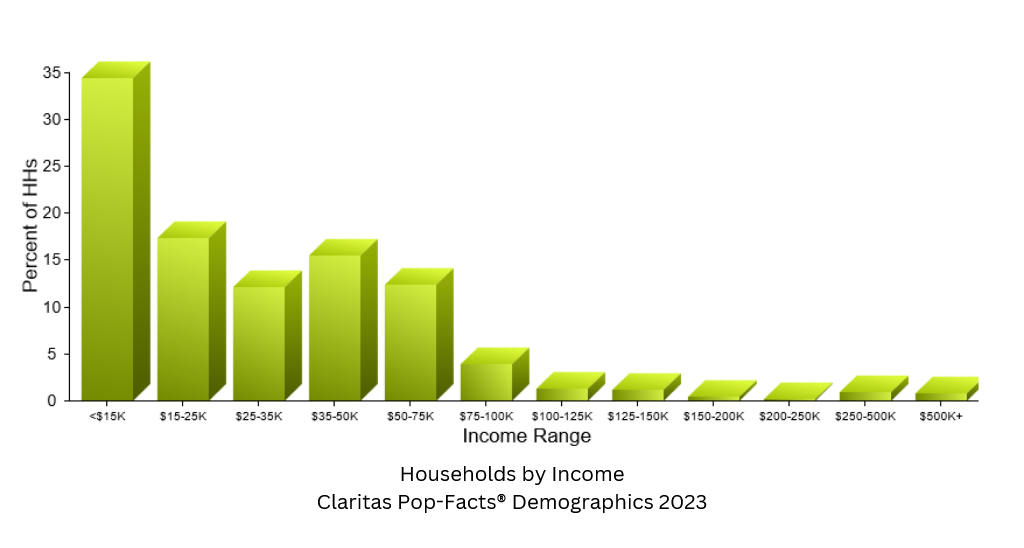
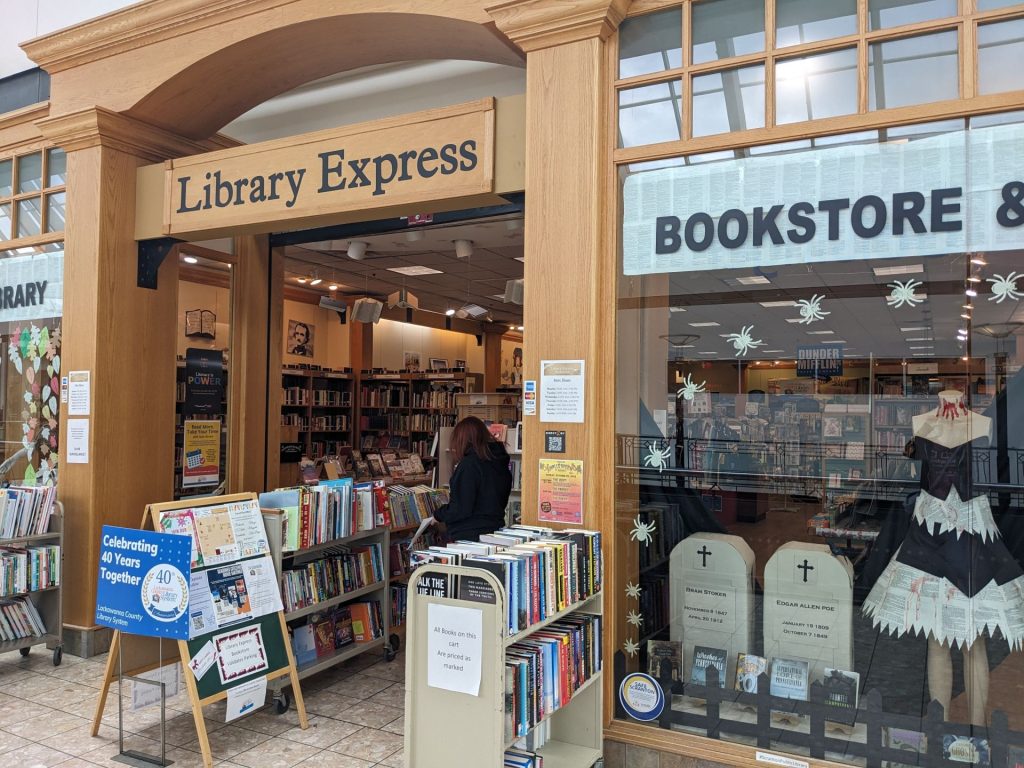
Another unique thing about Library Express is its location in Scranton’s local mall, the Marketplace at Steamtown. A mall is usually the place for big chain stores like Barnes and Noble, but Library Express anchors itself there just as well as these larger stores.
As a mall, the Marketplace reflects a sense of business and constant activity. However, in 2016, the Marketplace at Steamtown was rebranded as a community center with an emphasis on providing community resources and supporting the local economy, both of which directly align with Library Express’s goals.
Library Express is found on the second floor of the mall, a place where many of the neighboring stores are locally owned small businesses that you can’t find anywhere else. For example, Library Express’s direct neighbor is Dress for Success, a second-hand clothing store that specializes in providing professional clothing in addition to career services for women hoping to enter or reenter the workforce. The mall also hosts several businesses that support and provide opportunities for creators in the community, like Phyl Your Bags, a co-op of local artisans, and What the Wick, which sells homemade candles (see the complete directory here). Both of these businesses are examples of the value Scranton places on support for local entrepreneurs in its working-class environment. On the first floor of the mall, there’s even a branch of the Luzerne County Community College, which adds an atmosphere of learning and accessibility to the mall.
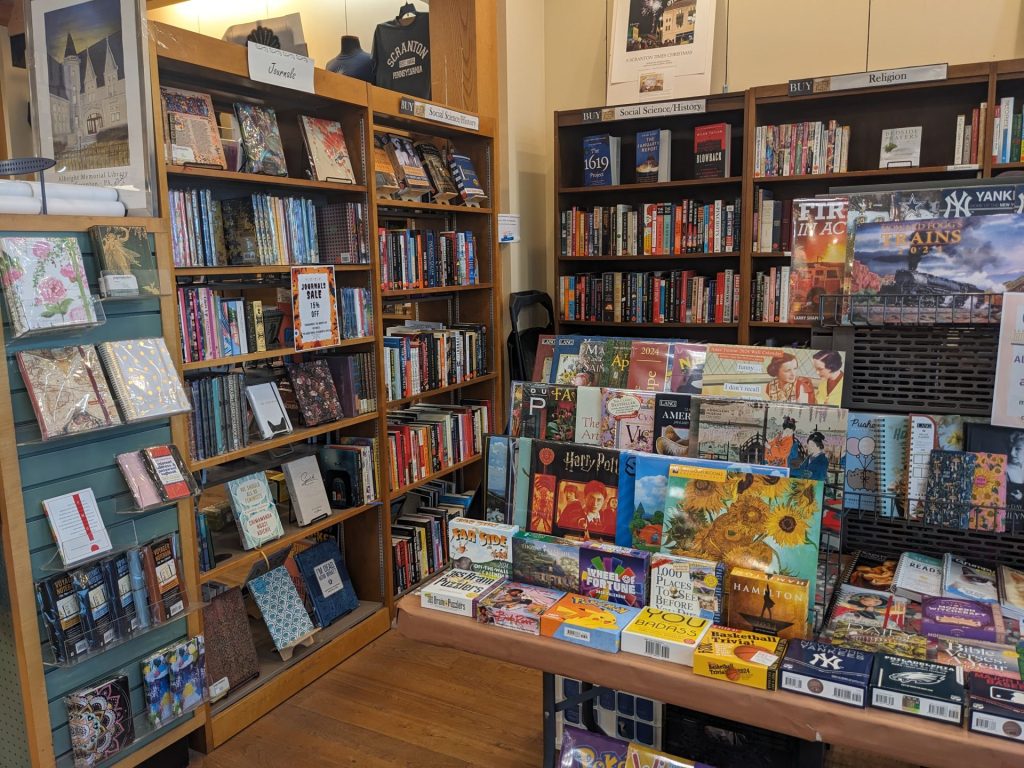
Laura J. Miller’s Reluctant Capitalists: Bookselling and the Culture of Consumption describes how the right kind of businesses are “nourished by their vital connections to a locality” and that they can “rise above the profit considerations to provide community service as well as customer service” (122). This is exactly what Library Express Bookstore does; it provides a much-needed public space where one might wander through the shelves of books, free from commercial obligation but confident that any money spent will directly benefit the Lackawanna County Library System. The way Library Express is designed makes you feel like an insider in the community, even if you’re only stopping in for a brief visit.
In “The Science and Recent History of Bookstore Design,” Lyndsie Manusos meditates on “how a bookstore should ‘reflect the style and traditions of its surroundings’” when forming its culture, design, and function within its community. In this manner, Library Express shows the influence of traditional mall shopping culture and organization, presenting its wares in straight, orderly lines and small, contained U-shapes of similarly coded books: classics and classic-adjacents, adult and YA, nonfiction and special interest, etc. Library Express seems to mirror the days when bookstores operated on practical commercial business models, though the store also provides a crucial emphasis on community care and engagement through its creative features and dual nature as a bookstore and public library.
Library Express exudes the same straightforward, entrepreneurial atmosphere that characterizes the rest of Scranton. You quickly recognize where to find the books you’re interested in, and while the layout encourages browsing and free movement, it’s perfectly suited to stopping in after work to pick up a new volume or borrow a book you’ve checked the availability of at the Lackawanna County Library System’s website lclshome.org. In this vein, the store “buys into” that consumer culture, meeting the needs of its working-class customers while still operating as a business.
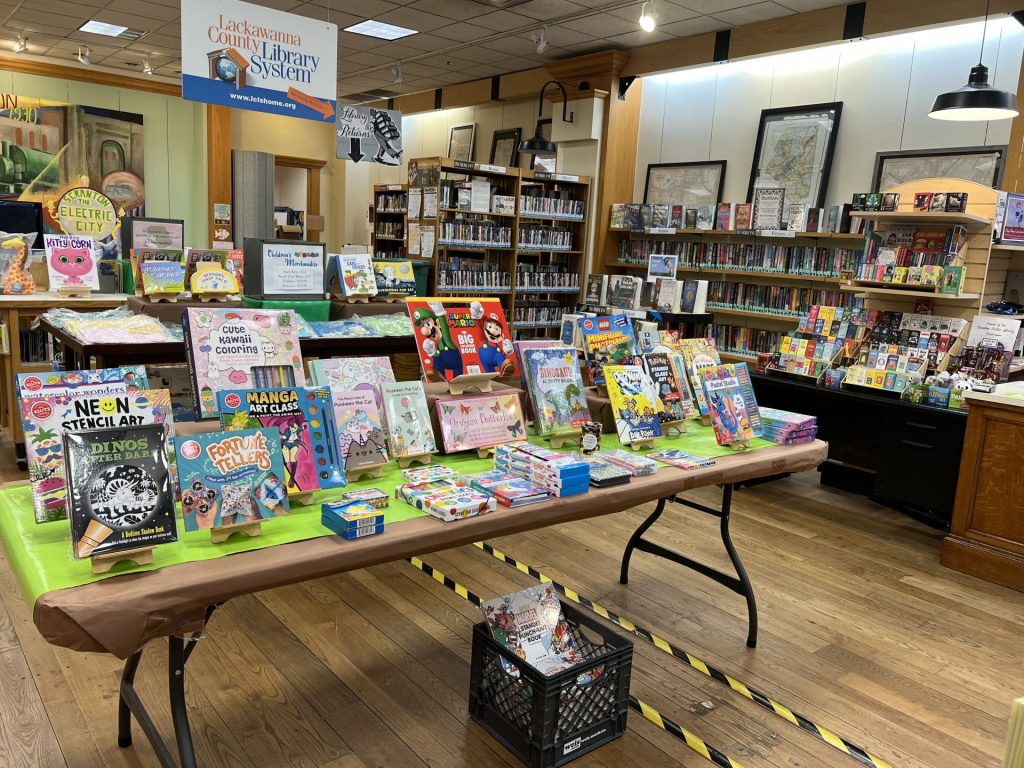
Library Express’s floor design and allocation of space also show its desire to put their customers’ needs first. In Reluctant Capitalists, Miller argues that “aside from any personal attachment to a locale, the [book]store proprietor knows that the fate of her entire business is tied to the future of that community” (226). In other words, booksellers are invested in their community’s well-being and must cater to their customers’ interests and values to stay afloat. Library Express does this by prioritizing certain genres or categories over others. For example, the cheapest books are the first things customers from the lower-income community of Downtown Scranton interact with, through book carts positioned outside the storefront. These carts convey a homey, casual atmosphere and a low-stakes first impression that invites people in because they know they can spend as much or as little as they want to once, they enter the space.
In terms of relative section size, Library Express’s ‘mainstream’ definition of literature is also indicative of its working-class climate in its stocking of mostly popular books that appeal to a broad section of the population, with less of an emphasis on highbrow intellectualism (though they still do carry a large collection of loosely defined classics).
A floorplan of Library Express showing the store’s commitment to community through its design. Color key: library spaces (purple), non-book items for sale (orange), books for sale (green).

The library collection of the hybrid bookstore is smaller than its neighbor the merch section, constituting less than a quarter of the store’s floor space. Despite this, it contains a huge assortment of large print texts and hundreds of DVDs that library card holders can borrow and enjoy for a quiet evening’s entertainment without having to spend hard-earned money. Given that approximately 33% of the population in downtown Scranton is 65 years or older (Claritas), this specialized selection of large print titles is a testament to Library Express’s dedication to serving all groups in the community, no matter their age group or socioeconomic background. It’s a place where anyone can go enjoy literature and library programming together, which lines up with the store’s emphasis on community engagement and activities.
By prioritizing its customers, Library Express brings a lot of life to the Marketplace at Steamtown with its colorful arrays, creative art displays, and emphasis on community involvement. It’s committed to positively impacting anyone who enters the store through its library resources and bookstore design and has been doing so ever since its introduction in 2012.
A timeline of important community events during Library Express’s history, from the origin of the store until the present.
The way that Library Express has formed a community is one that requires interaction from the consumers as well, though the initial formation of smaller communities is done by the store itself. For example, while there have been many diverse events hosted in the bookstore itself, the longest running have been the monthly book signings and readings. These began just 17 days after the store’s opening on January 11, 2012, with the signing of Nancy McDonald’s book If You Can Play Scranton. Since then, Library Express has hosted dozens of book signings, which often support the work of local writers. This tradition groups people of all ages in one place to give them a common interest and purpose with others. Library Express is perfect for such events because of how it serves the needs of an economically and generationally diverse community, especially since the initial goal of all libraries is to bring people together and strengthen bonds between different groups.
Other events are targeted towards more specific audiences, however. For example, community events include Teen Tuesdays, Seasoned Citizen Movie Matinees, children’s craft times, and specialized interest groups that meet in the back of the store. In Place, a Short Introduction by Tim Cresswell, places are defined both as “spaces which people have made meaningful” and “spaces people are attached to” (7), which soundly resonates with the groups in Library Express. Most of the recurring events have lasted for years, like the Open Mic Nights (since 2017) and the Seasoned Citizen Movie Matinees (since 2018). The smaller groups at these events form a community, and each group creates their own individual meaning in Library Express’s event space based on the types of programming targeted for them. Being with a group of like-minded people with similar interests creates relationships, both between the people at such events and the places they’re hosted in.

As a library/bookstore hybrid, it’s clear that the patrons and proprietors of the store truly care for books and their importance in the world. In his article, “Bookstores, Communist and Capitalist,” Jack Perry laments that bookstores haven’t been as mindful of this feeling in recent years: “No one in these places seems to love books, or even like them, except as money makers” (109). While this quote might apply to some other bookstores, it doesn’t apply to Library Express. The bookstore/library hybrid’s position as a nonprofit gives it a unique ability to counteract those tones and promote good literature without the pall of making a profit hanging over their business model. Library Express has adapted many times over the years to create deeper connections with people in the area and bridge the gap between bookselling and public service.
The function of Library Express is to serve the community, which they have done by creating meaning and community in a single place for the last decade. By combining the ethos of business with a legitimate need and drive to serve the community, Library Express has proven that it can survive the turbulence that shutters many other small businesses, and more impressively, does so as a hybrid bookstore in the working-class Rust Belt. It’s proof that Carrión might be wrong—the Library and the Bookstore do not have to be separate. When their goals of nurturing their community align, they can quite literally work as one to reap great success.
Thus, Library Express exists as a collection of opposites; the store emulates traditional consumer culture as more of a transactional retailer than an intellectual gatekeeper, but its design and curation still showcases its community-centric organization through the genres it prioritizes and its creative features. These features are perfectly aligned with creating a comfortable, welcoming atmosphere for Scranton’s working-class community, which has contributed significantly to the formation of relationships and community in Scranton.
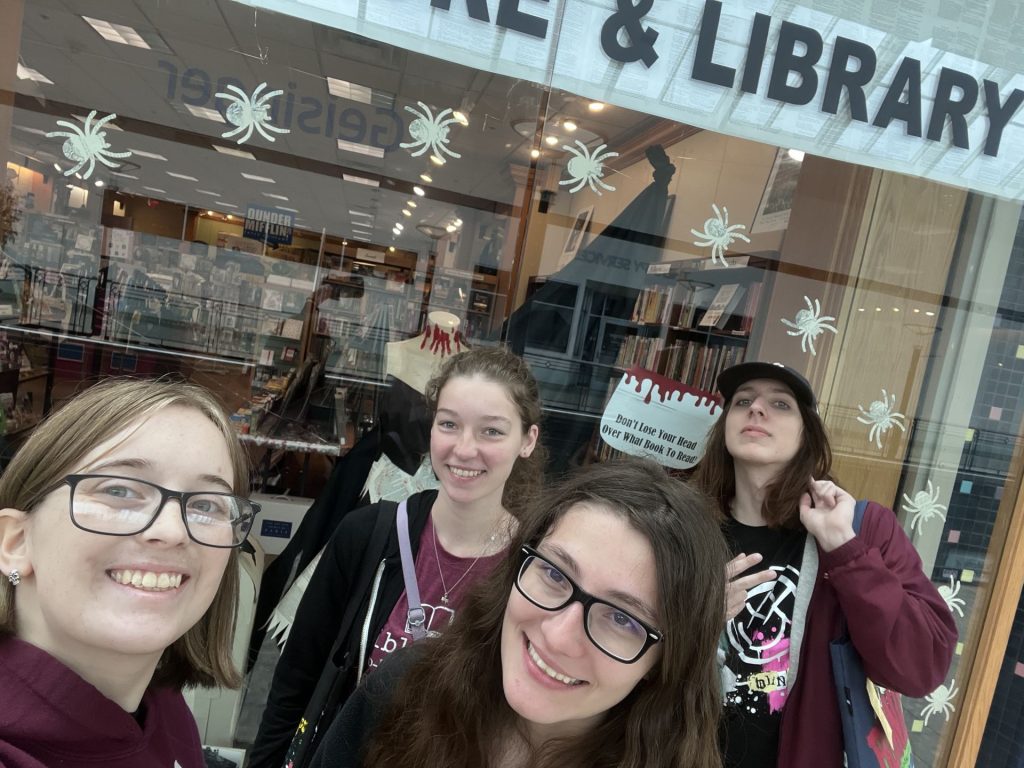
The authors of this post pictured in front of Library Express’s 2023 Halloween display: (left to right) Brooke Nelson, Amelia Alexander, Janina Reynolds, and Gavin Knouse.
Citations
Texts
Carrión, Jorge. Bookshops: A Reader’s History. Translated by Peter Bush, Biblioasis, 2017, pp. 37-40.
Cresswell, Tim. Place: A Short Introduction. Blackwell, 2011.
“Library Express Calendar.” Lackawanna County Library System, lclshome.org/library-express-calendar/. Accessed 8 Oct. 2023.
Manusos, Lyndsie. “The Science and Recent History of Bookstore Design.” BOOK RIOT, 22 Feb. 2022, bookriot.com/the-science-and-recent-history-of-bookstore-design/. Accessed 11 Dec. 2023.
Miller, Laura J. Reluctant Capitalists: Bookselling and the Culture of Consumption. University of Chicago Press, 2007. pp. 122-226.
Perry, Jack. “Bibliophilia: Bookstores, Communist and Capitalist.” The American Scholar, vol. 55, no. 1, 1986, pp. 107–11. JSTOR, http://www.jstor.org/stable/41211294. Accessed 11 Dec. 2023.
Images
All photos of Library Express taken by Amelia Alexander, Brooke Nelson, and Janina Reynolds on October 28, 2023 at Library Express Bookstore, Scranton, PA.
“Calendar of Events October 2023” from https://lclshome.org/b/library-express/. Accessed October 2023.
Graphics and Statistics
Floorplan drawn by Amelia Alexander in October 2023; floorplan annotations added using https://www.thinglink.com/. Accessed 10 Dec. 2023.
Google Map created by Janina Reynolds using https://mymaps.google.com/. Accessed 13 Dec. 2023.
Households by Income. Claritas, https://claritas360.claritas.com/mybestsegments/#zipLookup. Accessed 1 Dec. 2023.
Population by Age. Claritas, https://claritas360.claritas.com/mybestsegments/#zipLookup. Accessed 11 Dec. 2023.
Scranton, PA. Data USA. (n.d.). https://datausa.io/profile/geo/scranton-pa#demographics Accessed 1 Dec. 2023.
Timeline created by Brooke Nelson using Free Online Timeline Maker, https://time.graphics/. Accessed 29 Nov. 2023.

0 Comments